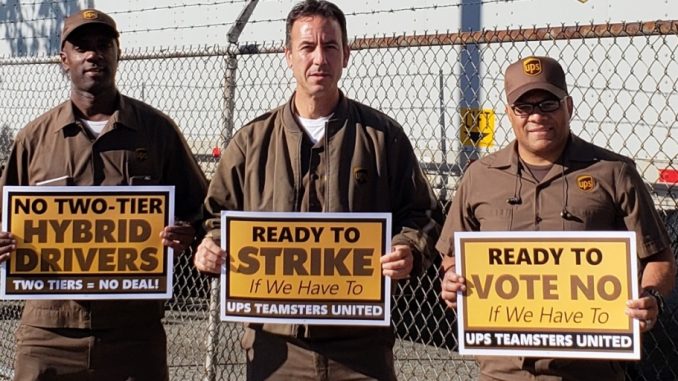
Teamsters Union members who work for UPS recently voted to reject a proposed contract. But the top officials of the Teamsters Union said that the voters actually approved the contract. The vote was 46 percent approving and 54 percent turning it down. But the union leadership said that fewer than 50 percent of the eligible members voted, and the rules require a two-thirds majority to turn it down. What kind of a rule is that? One that gives the union officials way more control than they should have. The workers had previously voted overwhelmingly to authorize a strike if the contract was defeated. But these officials found a legalistic way to avoid leading a strike.
This is the Teamsters’ biggest contract, representing around 250,000 workers. This contract is up for renewal every five years. Whatever the workers get or don’t get, they are stuck with it for a long time, unless they are ready to make a fight for what they need. So what were some of the main issues over which the workers were ready to strike?
The union leadership asked for and got a $13 per hour minimum wage for part-time workers. This is not a living wage. Even Amazon just announced a $15 minimum for workers doing similar work. Why not at least fight for the same pay as them?
- UPS wants to start a two-tier pay structure for truck drivers, with one tier for part-time weekend work that is less than what other drivers get. The official Teamsters leadership agreed. This would mean different pay for the same work for the same company – a clear attempt to divide the workers.
- The contract does not require UPS to create any more full-time jobs. They can continue to maximize their use of part-time workers to minimize costs through the lower minimum wage and the weekend rate.
- The contract continues to let UPS pit some workers against others through the use of subcontractors for some of the work that UPS Teamsters can do.
- The contract fails to address forced overtime issues that involve not only exhausting shifts but harassment of workers by supervisors.
Because the workers voted “No!” on the contract, all of these issues should be on the table. And the workers should be able to vote on any revisions. But the union leadership says it is going back to the table with the company because some regional contracts were not approved and it will look at all issues. The union officials’ claim that the national contract was approved means that they won’t submit it again to a vote. So what can we seriously expect?
The UPS Package contract was not the only one that workers voted down. UPS Freight handles large items and has a much smaller group of workers with a separate contract. They also voted their contract down. The union leadership says they renegotiated it and the workers should vote for it. But it’s almost the same. As of this writing, the revote hasn’t happened yet.
The situation of UPS workers is similar to what many workers face, whether they have a union or not. All bosses try to minimize costs at the workers’ expense. Bosses try all kinds of ways to divide workers against each other – full-time versus part-time, by race and gender, and so on. If we have a union, the officials often seem to be more on the bosses’ side than the workers’ side. So, what should we do?
First of all, workers need to understand that it’s essential to organize ourselves. The real union is the rank-and-file workers, not the officialdom like the Teamsters with its headquarters in Washington, DC within walking distance of the Capitol and the White House. If workers are to win anything, it will be because we organize ourselves to take on both the bosses and the official union leadership. Can it be done? In 1997, a rank-and-file upsurge by UPS workers led to a 16-day strike that won major concessions from UPS. So it can be done. It’s been done. Some UPS workers today still remember that strike. This year the workers voted to authorize a strike if they weren’t satisfied with the proposed contract, which they voted down. The union leadership tries to stand in the way while the workers are ready to fight. But the officials can’t drive the trucks and sort the packages in the warehouses. Workers need to recognize our power and use it.

